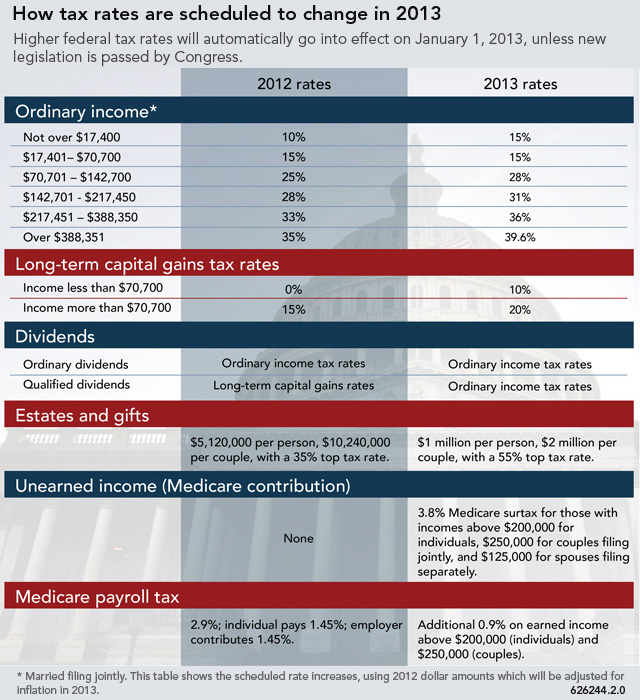Basics:
Tax Rate: 3.8%
Applies to: Individuals with adjusted gross income (AGI) above $200,000. Couples filing a joint return with more than $250,000 AGI.
Types of Income: Interest, dividends, rents (less expenses), capital gains (less capital losses)
Formula:
The new tax applies to the LESSER of
Investment income amount
Excess of AGI over the $200,000 or $250,000 amount
Examples:
Capital Gain: Sale of a Principal Residence
John and Mary sold their principal residence and realized a gain of $525,000. They have $325,000 Adjusted Gross Income (before adding taxable gain).
The tax applies as follows:
| AGI before taxable gain | $325,000 | |
| Gain on sale of Residence | $525,000 | |
| Taxable Gain (added to AGI) | $25,000 | ($525,000 – $500,000) |
| New AGI | $350,000 | ($325,000 + $25,000 taxable gain) |
| Excess of AGI over $250,000 | $100,000 | ($350,000 – $250,000) |
| Lesser amount (Taxable) | $25,000 | (Taxable gain) |
| Tax due | $950 | ($25,000 x 0.038) |
Capital Gain: Sale of a non-real estate asset
Barry and Michelle inherited capital assets that they have decided to liquidate. The sale of the assets generates a capital gain of $120,000. Their AGI before the gain is $140,000. They will pay the tax as follows:
| AGI before capital gain | $140,000 | |
| Gain on sale of assets | $120,000 | |
| New AGI | $260,000 | |
| Excess of AGI over $250,000 | $10,000 | |
| Lesser amount (Taxable) | $10,000 | (Excess over $250,000) |
| Tax due | $380 |
Capital Gains, Interest and Dividends: Securities
Harry and Sally have substantial income from their securities investments. Their AGI before including that income is $190,000. Their investment income is as follows:
| Interest Income (Bonds, CDs) | $60,000 | |
| Dividend Income | $75,000 | |
| Capital Gains | $10,000 | |
| Total Investment Income | $145,000 | |
| New AGI | $335,000 | ($190,000 + $145,000) |
| Excess of AGI over $250,000 | $ 85,000 | ($335,000 – $250,000) |
| Lesser amount (Taxable) | $ 85,000 | (AGI excess) |
| Tax Due | $ 3,230 | ($85,000 x .038) |
Rental Income: Income Sources Including Real Estate Investment Income
Hank has a “day job” from which he earns $85,000 a year. He owns several small apartment buildings and earns gross rents of $130,000. He also has expenses related to that income. Even though his combined gross rents and day job earnings are more than $200,000, he will not be subject to the 3.8% tax.
| AGI before rents | $85,000 | |
| Gross Rents | $130,000 | |
| Expenses (including depreciation) | $110,000 | |
| Net Rents | $20,000 | |
| New AGI | $105,000 | ($85,000 + net rents) |
| Excess of AGI over $200,000 | $0 | |
| Taxable amount | $0 | |
| Tax due | $0 |
Rental Income: Rental Income as sole source of Earnings – Real Estate Trade or Business
Henrietta’s sole livelihood is derived from owning and operating commercial buildings. Her income stream is as follows:
| Gross rents | $750,000 | |
| Expenses (including depreciation) | $500,000 | |
| Net rents | $250,000 | |
| AGI (rental income) | $250,000 | |
| Excess of AGI over $200,000 | $50,000 | |
| Taxable amount | $0 |
Because Henrietta’s rental income is from a trade or business and therefore not treated as investment income, she is NOT subject to the 3.8% investment income tax. Henrietta WILL be subject to new 0.9 tax on earned income, however, because some portion of the net rents represents her compensation for operating the commercial buildings.
For this example, assume that the net rents are her compensation. The tax on this earned income would be as follows:
| AGI | $250,000 | |
| Excess of AGI over $200,000 | $50,000 | |
| Tax due | $450 | ($50,000 x .009) |
